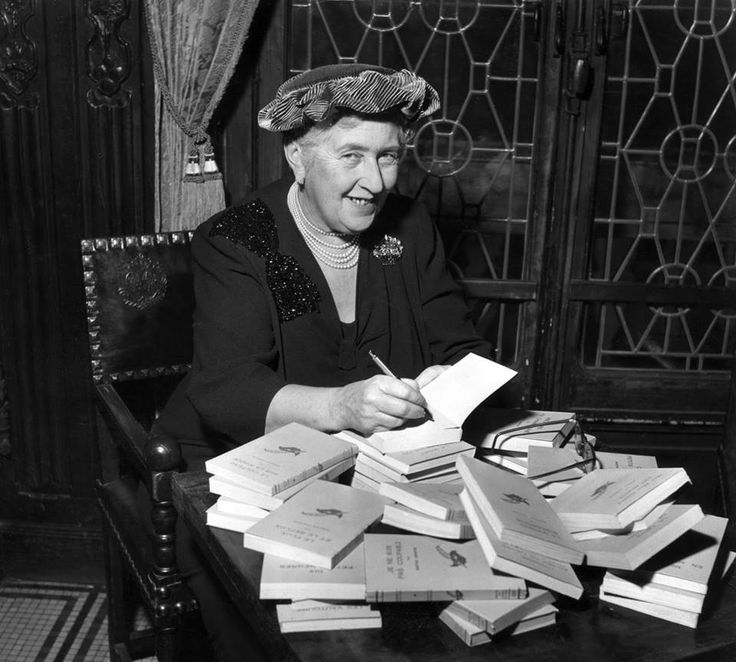 |
| (image from here) |
"'I know human nature,' said Miss Marple. 'It's impossible not to know human nature living in a village all these years.'" -The Thirteen Problems, p. 198
The Sum of It:
As a helpless mystery nerd, I cannot think of a more pleasant way to pass an evening than to get a small group of good friends together, put on a pot of tea, and try to deduce "unsolved mysteries." That is the premise of our first read of this week, The Thirteen Problems or, as it's know in the US, The Tuesday Club Murders (as a note, I purchased the UK version of this book, so that is why I refer to it by its UK name.)
The Thirteen Problems is a collection of short stories which were originally published in monthly fiction magazines starting in 1927, and were then published as a collection in 1932. Thirteen Problems is the world's first introduction to Agatha's second famous sleuth: Miss Jane Marple. Agatha wrote Miss Marple with her own grandmother in mind, and her description is decidedly matronly (think Dowager Countess #downtonabbey): black brocade dress, snowy white hair, constant knitting, etc. In Thirteen Problems we also meet some other Miss Marple regulars: her playboy-ish, famous author nephew Raymond West, Miss Marple's ex-Scotland Yard bestie Sir Henry Clithering, and the country couple to Miss Marple's third wheel from later novels, Colonel and Dolly Bantry.
In Thirteen Problems, Miss Marple is at first seen as a background observer (muttering to herself as she counts her knitting stitches) to a group game of Raymond, Sir Henry, and a few others as they each present a sort of cold case they observed or heard about from their past, with the idea that their brain powers combined can deduce the culprit. However, it's unassuming Miss Marple who schools everyone with the correct solution every time (#madrespect #yaskween). The second half of the book features Sir Henry and Miss Marple at a house party together sometime later with the Bantrys and a few other guests, and they try the game again...with Miss Marple 6 for 6 by the end of it.
Here's what I love about The Thirteen Problems: the short chapters make for a fun, easy read, with the guaranteed satisfaction of a solution every 20-odd pages. But more than that, the mysteries are clever and hint at some ideas Agatha implemented in her longer novels in the future. My personal two favorite stories are:
Murder vs. Opportunity: a dying man makes a drastic change to his will shortly before his death in full sight of his lawyer, and yet when the new will is taken from its sealed envelope to be read, it is found to be a blank sheet of paper! However, those suspects who had a motive for swapping out the will had no opportunity to do so, and those who had an opportunity had no motive! #MYSTERY
The Herb of Death: Sweet Dolly Bantry wants to participate with a story from her past, but is embarrassed about telling it as well as the others, so she gives the bare bone facts and then has everyone grill her 20 Questions-style for more details.
The YOA Treatment:
With the character of Miss Jane Marple, Agatha gives the reader yet another sleuthing style. Hercule Poirot has his order and logic method -- "the little grey cells," Tommy & Tuppence follow the paths they find in their favorite books, while Miss Marple relies heavily on her knowledge of the human nature. After being presented with the facts of a case, Miss Marple never fails to chime in with a story of someone back home in her village (#StMaryMead) that seems completely unrelated...until she presents her solution of the crime.
In her autobiography, Agatha gives some great insight into the influence her grandmother had on the character of Miss Marple. Agatha says of her grandmother: "though a cheerful person, she always expected the worst of everyone and everything, and was, with almost frightening accuracy, usually proved right. 'A downy fellow, that - I don't trust him,' Grannie would remark, and when later a polite young bank clerk was found to have embezzled some money, she was not at all surprised, but merely nodded her head." Like Grannie, Miss Marple doesn't need to take out her tweezers, collect overcoat fibers, or take extensive notes to solve crimes. She just goes with her first gut reaction, and trusts in her many years of experience with ordinary people behaving in ordinary ways. And she never fails to catch the killer actin just like she knew they would #playersgonnaplay.
In her autobiography, Agatha gives some great insight into the influence her grandmother had on the character of Miss Marple. Agatha says of her grandmother: "though a cheerful person, she always expected the worst of everyone and everything, and was, with almost frightening accuracy, usually proved right. 'A downy fellow, that - I don't trust him,' Grannie would remark, and when later a polite young bank clerk was found to have embezzled some money, she was not at all surprised, but merely nodded her head." Like Grannie, Miss Marple doesn't need to take out her tweezers, collect overcoat fibers, or take extensive notes to solve crimes. She just goes with her first gut reaction, and trusts in her many years of experience with ordinary people behaving in ordinary ways. And she never fails to catch the killer actin just like she knew they would #playersgonnaplay.























